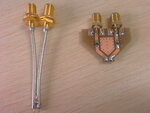rf1008
Full Member level 2
Hi all,
I used two-port VNA to measure DUT's impedance,and i can get S11/S22/S21/S12.
The measurement is done by dual coaxial pigtail and get some data,redo by PCB pigtails and also get some data. but i fond the datum are not the same,for example,Z11 from the VNA is 10-j100.2 by coaxial method,but Z11 from the VNA is 10.1-j140.5 by PCB method. The real parts are very similar but the imag parts are different very much.
Calibrations are done well and also the ports extensions are done well separately for two methods. Why the imag parts are so different.It's an easy measurement, coaxial cable is 50 Ohm and PCB trace is also 50 Ohm, length is short.
Attached picture is the coaxial pigtail and PCB pigtail. thanks a lot!
I used two-port VNA to measure DUT's impedance,and i can get S11/S22/S21/S12.
The measurement is done by dual coaxial pigtail and get some data,redo by PCB pigtails and also get some data. but i fond the datum are not the same,for example,Z11 from the VNA is 10-j100.2 by coaxial method,but Z11 from the VNA is 10.1-j140.5 by PCB method. The real parts are very similar but the imag parts are different very much.
Calibrations are done well and also the ports extensions are done well separately for two methods. Why the imag parts are so different.It's an easy measurement, coaxial cable is 50 Ohm and PCB trace is also 50 Ohm, length is short.
Attached picture is the coaxial pigtail and PCB pigtail. thanks a lot!
